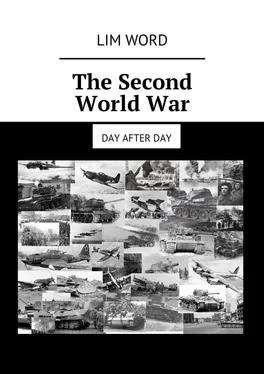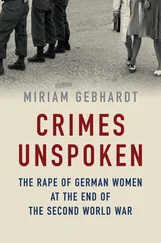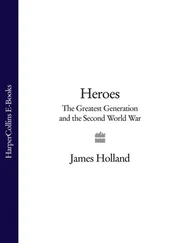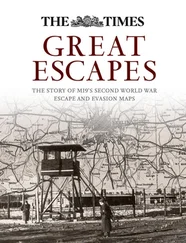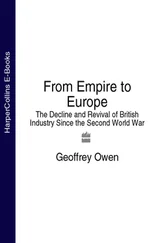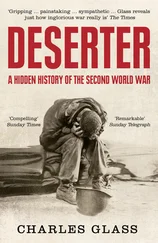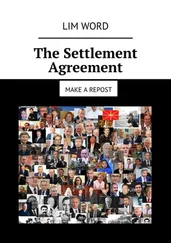Lim Word - The Second World War. Day after day
Здесь есть возможность читать онлайн «Lim Word - The Second World War. Day after day» — ознакомительный отрывок электронной книги совершенно бесплатно, а после прочтения отрывка купить полную версию. В некоторых случаях можно слушать аудио, скачать через торрент в формате fb2 и присутствует краткое содержание. ISBN: , Жанр: Политика, Справочники, Публицистика, История, на английском языке. Описание произведения, (предисловие) а так же отзывы посетителей доступны на портале библиотеки ЛибКат.
- Название:The Second World War. Day after day
- Автор:
- Жанр:
- Год:неизвестен
- ISBN:9785449071330
- Рейтинг книги:4 / 5. Голосов: 1
-
Избранное:Добавить в избранное
- Отзывы:
-
Ваша оценка:
- 80
- 1
- 2
- 3
- 4
- 5
The Second World War. Day after day: краткое содержание, описание и аннотация
Предлагаем к чтению аннотацию, описание, краткое содержание или предисловие (зависит от того, что написал сам автор книги «The Second World War. Day after day»). Если вы не нашли необходимую информацию о книге — напишите в комментариях, мы постараемся отыскать её.
The Second World War. Day after day — читать онлайн ознакомительный отрывок
Ниже представлен текст книги, разбитый по страницам. Система сохранения места последней прочитанной страницы, позволяет с удобством читать онлайн бесплатно книгу «The Second World War. Day after day», без необходимости каждый раз заново искать на чём Вы остановились. Поставьте закладку, и сможете в любой момент перейти на страницу, на которой закончили чтение.
Интервал:
Закладка:
The postwar policy of Yugoslav leader Josip Broz Tito – “Forgetting everything bad” only leads to the fact that in the early 1990s, non-repentant Croatian nationalists go on relapse, and unleash a bloody Civil War.
10. Flag of the National Socialist Party of Hungary “Crossed arrows”. In fact, the “Crossed Arrows” and its sole leader, Ferenc Salashi rule parallel to the government of Miklos Horthy. It is Horthy who initiates the entry of his state into the Second World War. The main goal, at the very beginning of the expansion, is the return of considerable territories, more than half of the country lost by Hungary under the Versailles Treaty. Further, the non-fascist formally Hungary, whether or not, is forced to participate in all military operations of Hitler’s Germany.
In October 1944, the Horthy government announced a truce with the USSR. A detachment of saboteurs Otto Skorzeni kidnaps Horty’s son. Under such pressure, the head of state transfers powers to Ferenc Salashi, and moves away from business.
The “Crossed Arrows” party rules until March 1945.
The way to power was determined after Hitler was sent to the army propaganda courses: his speeches were noticed by influential people. Fourteen years later, A.G. becomes simultaneously Reichspresident and Reichskanzlerom; These long names are shortened to the word “Fuhrer” – “leader.”
The first speeches of Hitler in this post are reduced to defining the world as an unconditional value, however, one way or another, its achievement follows from the return of lands lost by Germany after the Great War.
Landmark of the German Fuhrer – the movement of “blackshirts” in Italy. Since 1919, this southern country is experiencing a “red two-year”. The workers organize election committees on the direct model of the Soviets in Red Russia, seize enterprises, and try to control them more or less efficiently. The example of the USSR that is formed in general, does not bring inspiration to the Italian proletariat: this is a civil war, the physical annihilation of classes, mutual embitterment, power structures that seem to be completely out of control, apparently to no one at all. The red two-year period is replaced by the second anniversary of black. In October 1921 the squadrist, a voluntary national security militia, in the number of about 5,000 people, organize a march to Rome. King of Italy Victor Emmanuel meets with the head of the fascists Benito Mussolini, confirms him as prime minister.
The main idea of the Mussolini duce is a corporate state, the unification of classes on the basis of a common nationality and awareness of the exclusivity of their state. Introduced in particular, the laws on the inadmissibility of mixed marriages of Italians with non-Europoid races. The dialectic of fascism rejects peace, tranquility as some absolute value, recognizes war, and other perturbations are an indispensable means of improving mankind.
In general, Italian fascism is much milder than Hitler’s National Socialism. Whatever it was, the corporate state gives its citizens stability, work, a piece of bread and some enthusiasm. It successfully fights with, it would seem, a national brand, and the disaster of Italy – the mafia. However, the payment for such a way of uniting the masses, albeit with some delay – participation in many bloody battles of the Axis bloc in the South and East.
The ideology of fascism, to a greater or lesser degree, takes possession of many European states: Spain, France, Hungary, Austria, Romania, Croatia, Portugal, etc. In Japan, since 1938, in fact, the plan of “Great East Asia "– free from European influence, but under the direct control of the Land of the Rising Sun zone; which includes, among many other things, the whole of China. Militarism is not quite fascism, since it is not tied to a single charismatic dictator. This structure implies controlled tension in society, the creation of an image of an insidious external enemy, overstated by the military economy (albeit at the expense of the most important social programs), extensive external expansion.
You can argue a lot about the hidden springs of a gradually unfolding unthinkable action. One of them, usually not mentioned by historians, as something insignificant, is the massive use of German troops, the population and leadership of the Reich, psychotropic substances. Tobacco smoking is not welcome, although in a combat situation this is perhaps the best way to relieve stress. In the course of “Pills of cheerfulness”, pervitin (methamphetamine), the official component of the combat diet of German soldiers. The narcotic, which generates a sense of omnipotence, impunity, a psychoactive drug, is a part of food products, for example “tank chocolate” and sweets. Massively applied since 1938. The Wehrmacht receives about 12 million tablets a month from Temmler and Knoll, with a recommended dose of 2 tablets per day. According to some reports, by the time of the invasion of France, production has reached 833,000 pills per day. Hitler does not smoke tobacco, but takes pervitin from his personal physician Theodore Morrell since 1936 (actually, the beginning of expansion); since 1943 – several doses per day.
This drug, in addition, mobilizes forces, as if the body received a signal of danger – although, in fact, there can be no threat. But, subsequently, after such energy stimulation leading to numerous injuries, nerve cells die hundreds of thousands per day. It is interesting that the drug is recommended for mass consumption, like a panacea, even, for example, to treat female frigidity, and to facilitate delivery. It can not be said that the German authorities specifically promote the spread of pervitin; but they do not interfere with its spread at all.
…In 1930, Germany produces 200 tons of heroin, deploys also the production of other, cheaper, synthetic drugs. Overseas territories have been lost, according to the Versailles Treaty, however, many Latin American countries are willing to supply raw materials. Initially, aspiring to sole authority over the consciousness of its citizens, the National Socialist Party of Germany (NSDAP) strongly opposes the use of opiates. The concept is introduced: “Your own body belongs, first of all, to the family and the nation”, in contrast, it seems, really decadent thesis of the Weimar Republic: “Your body belongs only to you.” However, synthetic drugs, now called “energy stimulants,” thanks, in addition to everything, to Hitler, just drop out of the list of banned drugs.
In 1929, Nuremberg created the National Socialist Union of German Doctors, which, by the end of 1933, had 11,000 participants (23% of all German medical personnel). They, based on the data of their patients, create “files of heredity archives”. The main idea – the mentally retarded people do not have a right to exist – which, for the sake of humanity and prosperity of the nation, should be broken off in one way or another. Already since 1933, representatives of this union occupy leading positions, informally dispose of a gradual reduction in the standards for supplying food to patients of care and medical institutions – up to a lethal outcome.
Since October 9, 1935, almost legal, the T-4 program starts (from the name of the street Tigartentstrasse, house 4, where the headquarters of this organization was located), designed to reduce the population of Germany by the formula 1000: 10: 5: 1. Out of a thousand people, ten are disabled – five of them should be assisted, one physically eliminated. Planck rises: it now follows “To destroy all those who are unable to work productively, and not only deprived of reason.” In total, before September 1, 1941, 70,273 of its citizens were killed in German hospitals: at least 885 million marks were saved for the Army and Government. At the same time, German doctors working in the program receive monetary allowance more than anywhere else in the Reich. For each “processed dossier”, that is, the death of the patient, a fee of 100 Reichsmarks is paid – plus the use of the food stamps of the deceased remaining in the course of the month before the end of the month, the issuing of bills for his relatives to his relatives, within the specified time, and, gold crowns.
Читать дальшеИнтервал:
Закладка:
Похожие книги на «The Second World War. Day after day»
Представляем Вашему вниманию похожие книги на «The Second World War. Day after day» списком для выбора. Мы отобрали схожую по названию и смыслу литературу в надежде предоставить читателям больше вариантов отыскать новые, интересные, ещё непрочитанные произведения.
Обсуждение, отзывы о книге «The Second World War. Day after day» и просто собственные мнения читателей. Оставьте ваши комментарии, напишите, что Вы думаете о произведении, его смысле или главных героях. Укажите что конкретно понравилось, а что нет, и почему Вы так считаете.
